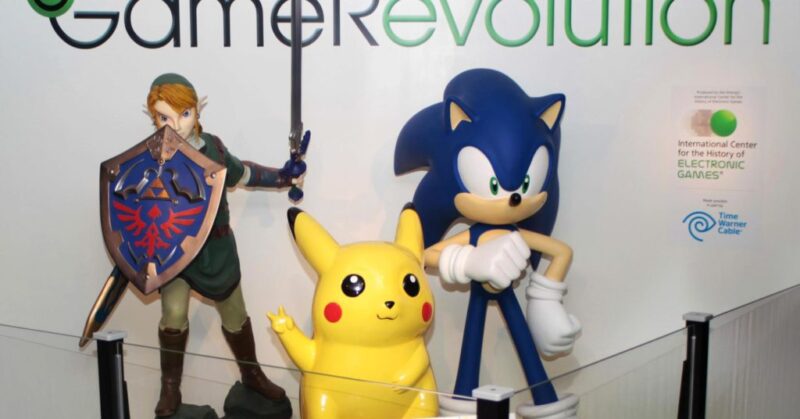“Street Fighter” and “Donkey Kong” are among the five classic video games announced as new additions to the World Video Game Hall of Fame for 2017, in recognition of their historic and cultural significance.
The World Video Game Hall of Fame, housed in The Strong museum in Rochester, New York, recognizes and celebrates individual video games that have enjoyed significant popularity and their cultural impact.
The five games inducted for 2017 join 12 others and span the history of video games. The titles were selected based on their iconic status, their continued popularity, their geographical reach and their influence on games development, entertainment and pop culture.
Donkey Kong
Released in 1981, “Donkey Kong” was one of the first games directed and designed by Shigeru Miyamoto, who went on to create several iconic video games at Nintendo such as “Super Mario Bros.” and “The Legend of Zelda.”
“Donkey Kong” was an arcade machine featuring the character Jumpman as he attempted to rescue his girlfriend Pauline from the eponymous Donkey Kong, a large ape who threw barrels at the player. Jumpman became the inspiration for Nintendo’s iconic mascot Mario, who has starred in over 200 video games.
“Without Donkey Kong there would be no Super Mario Bros., a member of the inaugural class of the World Video Game Hall of Fame,” says Jon-Paul Dyson, director of The Strong’s International Center for the History of Electronic Games, in a press release.
“But Donkey Kong is also about much more than one character. Its overarching narrative of love and its vibrant graphics brought the game to life in a way that few other games could in the early 1980s. It captured the hearts of a generation.”

Halo: Combat Evolved
The first game in the “Halo” franchise came out in 2001 as a launch title with Microsoft’s Xbox console. The game, set in a science-fiction universe, revolutionized the first-person-shooter genre, making it work better for consoles. Previously, the genre was most popular with PC gaming.
“Until Halo’s launch, the most successful shooters required a personal computer and the precision offered by a high-quality mouse,” explained The Strong’s associate curator Shannon Symonds in a press release.
“Halo proved a console could be just as effective, if not better, than a PC. It also boasted one of the strongest multiplayer experiences of its time.”
The Halo series has sold over 65 million copies worldwide and has spawned several spin-offs, books, comics, animation and live-action series.

Pokemon Red and Green
The original games first released in Japan in 1996 and later released as “Pokemon Red” and “Pokemon Blue” in North America, Europe and Australia, became a cultural phenomenon. As well as several games, the Pokemon franchise includes toys, a trading card game, a long-running television series and several films.
The games required players to capture, train and fight monsters, with a main objective of collecting all 151 unique Pokemon. A clever element to the game was that certain monsters were exclusive to one version of the game, meaning players had to meet in real life to trade their monsters with one another, or own both versions of the game.
The continued relevance and popularity of the brand was visible with last year’s “Pokemon Go” craze, where players used their phones to walk around real locations in order to find and capture monsters.
“The key driver of Pokemon Go’s achievement has been the strength of the Pokemon brand that has been built up over the last 20 years and the strong nostalgia element associated with it,” George Jijiashvili, wearables and VR analyst at CCS Insight, told CNBC via email last August.
“It is unsurprising that Nintendo saw increased sales of their game consoles, because those who enjoyed Pokemon games as kids in the 90’s and early 2000’s are now adults with disposable incomes.”

Street Fighter II
The release of “Street Fighter II: The World Warrior” in 1991 sparked an arcade renaissance in 1990s, according to the World Video Game Hall of Fame. The game, a sequel to 1987’s “Street Fighter”, required players to fight one-on-one using a wide cast of vivid, iconic characters and to learn complex combinations of movements and attacks.
It was a huge commercial success, selling more than 60,000 of the original arcade cabinets. The title also had a huge cultural impact, helping to define the fighting game genre.
“Street Fighter II allowed for head-to-head battles between human opponents, instantly attracting spectators and generating fierce tournament play in arcades across the world,” said Jeremy Saucier, assistant director of The Strong’s International Center for the History of Electronic Games, in a press release.
“This communal style of game play reinvigorated the arcade industry in the 1990s and helped give birth to a generation of fighting games.”
The Street Fighter series remains popular, with players competing in Esports Championships around the world.

And the rest
These five games join several other members of the World Video Game Hall of Fame: “DOOM”, “Grand Theft Auto III”, “The Legend of Zelda”, “The Oregon Trail”, “Pac-Man”, “Pong”, “The Sims”, “Sonic the Hedgehog”, “Space Invaders”, “Super Mario Bros.”, “Tetris”, and “World of Warcraft”, which are on permanent display in The Strong museum’s eGameRevolution exhibit.
“Pong” is one of the first arcade video games ever made, released by Atari in 1972. This electronic game of ping pong saw players try and bounce a ball between two paddles and score points.
“DOOM”, released in 1993, is considered one of the most significant and influential games of all times. It helped to establish the first-person shooter genre and was a huge step forward in terms of video game graphics. The game engine, developed by programmer John Carmack, featured highly dynamic graphics and visuals to create a seemingly realistic 3D space. The ability of the game to allow players to create custom mods and levels has helped the game maintain its popularity and ubiquity.




